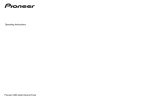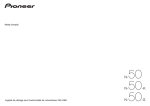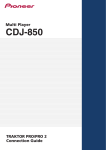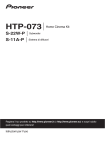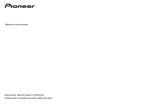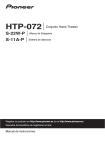Download Pioneer N-50-K Operating instructions
Transcript
Operating Instructions NNDriver software for USB D/A Converter Functionality N- 50 50 50 -K -S About these Operating Instructions The N-50 is equipped with a USB D/A converter function that allows you to play high-quality music files stored on your computer, or the use of a media streaming service to play music files from the internet. Files can be played merely by connecting the N-50 to your computer by means of a USB cable, but in order to use the D/A converter function, a dedicated driver must be installed on your computer. These operating instructions provide a wide range of information regarding use of the USB D/A converter function, from instructions on how to install the driver software on your computer, to help with troubleshooting issues. Installing the driver software Download and use the compressed installation program (Setup.exe) to install the driver on your computer. The compressed installation program file will be saved in the folder you designate at the time of download. Note •It is unnecessary to install the driver when using Mac OS X. 1 Use the USB cable to connect the N-50 to your computer. Turn on the power to the N-50. Computer Environment To utilize this driver, your computer must be equipped with a USB port supporting USB Rev2.0 HS. Use of the USB D/A converter function has been confirmed with the following operating systems. •Microsoft® Windows® XP (32 bit) •Microsoft® Windows® Vista (32 bit/64 bit) •Microsoft® Windows® 7 (32 bit/64 bit) •Mac OSX 10.6 10.7 USB A–type AL OUT DIGITAL IN COAXIAL 2 1 OPTICAL COAXIAL DC OUTPUT for WIRELESS LAN ADAPTER PORT AC IN (OUTPUT 5V 0.1A MAX) DIGITAL IN (OUTPUT 5V 0.6A MAX) Note • Operation has been confirmed with the following media player software: for Windows OS, Windows Media Player 11/12. For the MAC OS, iTunes 10.4. •In order to play music files on your computer using a Digital In USB port, it is recommended that you close all programs other than the media player software. •Supported sampling rates / bits rates may differ depending on your computer’s OS and the version of media player software used. Microsoft ®,Windows ® Vista, and Windows ® XP are either registered trademarks or trademarks of Microsoft Corporation in the United States and/or other countries. 2 USB B–type 2 Extract the compressed file contents to the desired folder, then click on the “Setup.exe” installer program in the folder. The InstallShield wizard will appear. 3 Click on [Next]. 4 Click on [Install]. 5 Click on [Finish]. The driver installation is completed. 6 Reboot your computer to finalize installation of the driver. Procedure finished. To uninstall the driver 1 Click on the [Start] button at lower left of your monitor screen, then click on ([Settings] t ) [Control Panel]. 2 From the Control Panel menu, click on [Add or Remove Programs]. 3 Select [Pioneer USB Audio Device] and click [Remove]. The uninstaller dialog will appear. The following screen will appear; wait until the step 5 instructions appear. 4 Click [Next] to execute the uninstall process. The driver software will be uninstalled. 5 Reboot your computer. Procedure finished. 3 Troubleshooting (Windows XP) 4 Click on [Sound, video and game controllers] and confirm that [Pioneer USB Audio Device] is listed. When using Windows Vista, see page 6 ; for Windows 7, see page 10 ; for Mac OS X, see page 14. 1. No sound In the event the N-50’s power is set to Standby, or the source input is set to something other than Digital In USB, do not start your computer’s media player software. Change the input to Digital In USB before starting your computer’s media player. 1 Click on [Start] t ([Settings] t ) [Control Panel] t [System]. 2 Click on the [Hardware] tab then click on [Device Manager]. 3 Click on [Universal Serial Bus controllers] and confirm that [USB Composite Device] is listed. If the above devices are not listed as described, confirm that the N-50’s input source is set to Digital In USB, then either disconnect and reconnect the USB cable, or set the power to Standby then turn it On again. 5 Click on [Start] t ([Settings] t ) [Control Panel] t [Sound, Speech, and Audio Devices] t [Sounds and Audio Devices]. 6 Open the sound and audio Properties. Procedure continues. Procedure continues. 4 7 Click on the [Audio] tab, then confirm that [Pioneer USB Audio Device] is listed as the [Default device] for [Sound playback]. t If another device has been selected, open the drop-down menu and select [Pioneer USB Audio Device], then click on [Apply] to change the selection. 2. To disable the operating system’s sound scheme Under default OS settings, computer events may be accompanied by audio signals and beeps that are audible through the speakers attached to the N-50. In the event you do not wish to hear such non-music signals, follow the instructions listed below: 1 Click [Start] t [Control Panel] t [Sounds and Audio Devices]. 2 Click on the [Sounds] tab, and for the [Sound scheme], select [No Sounds], then click on [Apply]. 8 To enable the new setting, reboot your computer. 9 Confirm that your media player’s sound volume is set to Maximum. In the event your media player requires an output plugin setting, confirm that [Pioneer USB Audio Device] is selected. Procedure finished. Procedure finished. 5 Troubleshooting (Windows Vista) 3 Click on [Sound, video and game controllers] and confirm that [Pioneer USB Audio Device] is listed. When using Windows XP, see page 4; for Windows 7, see page 10; for Mac OS X, see page 14. 1. No sound In the event the N-50’s power is set to Standby, or the source input is set to something other than Digital In USB, do not start your computer’s media player software. Change the input to Digital In USB before starting your computer’s media player. 1 Click on [Start] t [Control Panel] t [System and Maintenance] t [System]. 2 From the [Tasks] list, click on [Device Manager]. 4 Click on [Universal Serial Bus controllers] and confirm that [USB Composite Device] is listed. Procedure continues. If the above devices are not listed as described, confirm that the N-50’s input source is set to Digital In USB, then either disconnect and reconnect the USB cable, or set the power to Standby then turn it On again. Procedure continues. 6 5 Click on [Start] t [Control Panel] t [Hardware and Sound] t [Sound]. 6 Under the [Playback] tab, confirm that for [Speakers], [Pioneer USB Audio Device] is checked as the default device. 8 Under the [Levels] tab, set the [Speakers] level to maximum. If the Speaker Mute indicator (at the left side of the Balance button) is lighted, click it to turn it off. t If another device has been selected, select [Pioneer USB Audio Device], and click to [Set Default]. Speakers 9 Confirm that your media player’s sound volume is set to Maximum. 7 Double click on [Speakers] ([Pioneer USB Audio Device]), and display its Properties. In the event your media player requires an output plugin setting, confirm that [Pioneer USB Audio Device] is selected. Procedure finished. Procedure continues. 7 2. To disable the operating system’s sound scheme Under default OS settings, computer events may be accompanied by audio signals and beeps that are audible through the speakers attached to the N-50. In the event you do not wish to hear such non-music signals, follow the instructions listed below: 1 Click [Start] t [Control Panel] t [Hardware and Sound] t [Sound]. 2 Click on the [Sounds] tab, and for the [Sound scheme], select [No Sounds], then click on [Apply]. 3. To set the sampling frequency for audio data output from your computer By synchronizing the sampling frequency of playback files with the transmission sampling rate, sound can be transmitted without the need for frequency conversion. When a high sampling frequency is set on a computer with inadequate processing capacity, audio playback may be disrupted. In this event, the bit rate and frequency should be set to low values such as 2-channel, 24-bit, 44100 Hz. 1 Click on [Start] t [Control Panel] t [Hardware and Sound] t [Sound]. 2 Under the [Playback tab], for [Speakers], double click on [Pioneer USB Audio Device] to display the Properties. Procedure finished. Procedure continues. 8 3 Under the [Advanced] tab, select for [Default Format] the desired output sampling rate, then click on [Apply]. Procedure finished. 9 Troubleshooting (Windows 7) 4 Click on [Universal Serial Bus controllers], and confirm that [USB Composite Device] is listed. When using Windows XP, see page 4; for Windows Vista, see page 6; for Mac OS X, see page 14. 1. No sound In the event the N-50’s power is set to Standby, or the source input is set to something other than Digital In USB, do not open your computer’s media player software. Change the input to Digital In USB before starting your computer’s media player. 1 Click on [Start] t [Control Panel] t [System and Security]. 2 Under [System], click on [Device Manager]. 3 Click on [Sound, video and game controllers] and confirm that [Pioneer USB Audio Device] is listed. If the above devices are not listed as discribed, confirm that the N-50’s input source is set to Digital In USB, then either disconnect and reconnect the USB cable, or set the power to Standby then turn it On again. 5 Click on [Start] t [Control Panel] t [Hardware and Sound] t [Sound]. Procedure continues. Procedure continues. 10 6 Under the [Playback] tab, confirm that for [Speakers], [Pioneer USB Audio Device] is checked as the [Default Device]. t If another device has been selected, select [Pioneer USB Audio Device], and click on [Set Default]. 8 Under the [Levels] tab, set the [Speakers] level to maximum. If the Speaker Mute indicator (at the left side of the Balance button) is lighted, click it to turn it off. Speakers 9 Confirm that your media player’s sound volume is set to Maximum. 7 Double click on [Speakers] ([Pioneer USB Audio Device]), and display its Properties. Procedure continues. In the event your media player requires an output plugin setting, confirm that [Pioneer USB Audio Device] is selected. Procedure finished. 11 2. To disable the operating system’s sound scheme Under default OS settings, computer events may be accompanied by audio signals and beeps that are audible through the speakers attached to the N-50. In the event you do not wish to hear such non-music signals, follow the instructions listed below: 1 Click [Start] t [Control Panel] t [Hardware and Sound] t [Sound]. 2 Click on the [Sounds] tab, and for the [Sound scheme], select [No Sounds], then click on [Apply]. 3. To set the sampling frequency for audio data output from your computer By synchronizing the sampling frequency of playback files with the transmission sampling rate, sound can be transmitted without the need for frequency conversion. When a high sampling frequency is set on a computer with inadequate processing capacity, audio playback may be disrupted. In this event, the bit rate and frequency should be set to lower values such as 2-channel, 24-bit, 44100 Hz. 1 Click on [Start] t [Control Panel] t [Hardware and Sound] t [Sound]. 2 Under the [Playback] tab, for [Speakers], double click on [Pioneer USB Audio Device] to display the Properties. Procedure finished. Procedure continues. 12 3 Under the [Advanced] tab, select for [Default Format] the desired output sampling rate, then click on [Apply]. Procedure finished. 13 Troubleshooting (Mac OS X) When using Windows XP, see page 4; for Windows Vista, see page 6; for Windows 7, see page 10. 1. No sound 2. To disable the operating system’s sound scheme Under default OS settings, computer events may be accompanied by audio signals and beeps that are audible through the speakers attached to the N-50. In the event you do not wish to hear such non-music signals, follow the instructions listed below: 1 Click [System Preferences…] t [Sound]. In the event the N-50’s power is set to Standby, or the source input is set to something other than Digital In USB, do not start your computer’s media player software. Change the input to Digital In USB before starting your computer’s media player 2 Click on [Sound Effects] tab, and for the item [Selected sound output device], click [Internal Speakers]. 1 Click on [System Preferences…] t [Sound]. 2 Select the [Output] tab, then under [Select a device for sound output], select [Pioneer USB Audio Device]. 3 Select the [Output] tab, and for the item [Select a device for sound output], click on [Pioneer USB Audio Device]. If the above devices are not listed as described, confirm that the N-50’s input source is set to Digital In USB, then either disconnect and reconnect the USB cable, or set the power to Standby then turn it On again. Procedure finished. 14 Procedure finished. 3. To set the sampling frequency for audio data output from your computer By synchronizing the sampling frequency of playback files with the transmission sampling rate, sound can be transmitted without the need for frequency conversion. 2 Select [Pioneer USB Audio Device]. 3 Select the bit rate and sampling frequency for the desired audio file. 1 Click on [Finder] t [Applications] t [Utilities] t [Audio MIDI Setup]. 2 3 Procedure finished. Procedure continues. 15 © 2011 PIONEER CORPORATION. All rights reserved. PIONEER CORPORATION 1-1, Shin-ogura, Saiwai-ku, Kawasaki-shi, Kanagawa 212-0031, Japan PIONEER ELECTRONICS (USA) INC. P.O. BOX 1540, Long Beach, California 90801-1540, U.S.A. TEL: (800) 421-1404 PIONEER ELECTRONICS OF CANADA, INC. 340 Ferrier Street, Unit 2, Markham, Ontario L3R 2Z5, Canada TEL: 1-877-283-5901, 905-479-4411 PIONEER EUROPE NV Haven 1087, Keetberglaan 1, B-9120 Melsele, Belgium TEL: 03/570.05.11 PIONEER ELECTRONICS ASIACENTRE PTE. LTD. 253 Alexandra Road, #04-01, Singapore 159936 TEL: 65-6472-7555 PIONEER ELECTRONICS AUSTRALIA PTY. LTD. 5 Arco Lane, Heatherton, Victoria, 3202, Australia, TEL: (03) 9586-6300 PIONEER ELECTRONICS DE MEXICO S.A. DE C.V. Blvd.Manuel Avila Camacho 138 10 piso Col.Lomas de Chapultepec, Mexico, D.F. 11000 TEL: 55-9178-4270 K002_B3_En <ARB7465-A>
















